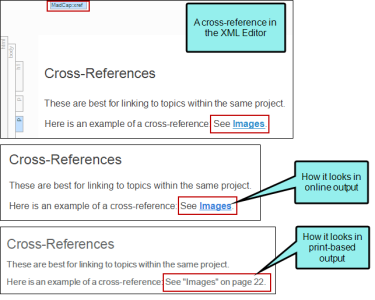A cross-reference is an automated link that is based on a format with commands. This method of linking saves time because you don't have to type the link text each time, or manage it over time if the destination content changes. Cross-references are recommended when you are linking from one place in your project to another (as opposed to linking to external files or websites).
Warning It is recommended that you avoid creating links to snippets.This is primarily due to the nature of snippets, which are designed to be inserted into multiple files. Let's say you have a heading style in a snippet and that snippet is then inserted into 12 different topics. In another topic, you might decide to create a cross-reference that points to the heading in that snippet. But which of those 12 topics is it supposed to point to in the output? There is no way for Flare to know this, so you could end up with some very undesirable results. For this reason, it's a good idea not to link to any content in a snippet.
Note You can use the built-in analysis tool and reports to find broken links.
Note You can generate a report to see places in your project where you might want to create a cross-reference. Essentially, Flare finds files where a hyperlink to a topic exists. Because cross-references are generally preferred over hyperlinks (due to the fact that they are dynamic), it suggests that you create a cross-reference instead.











